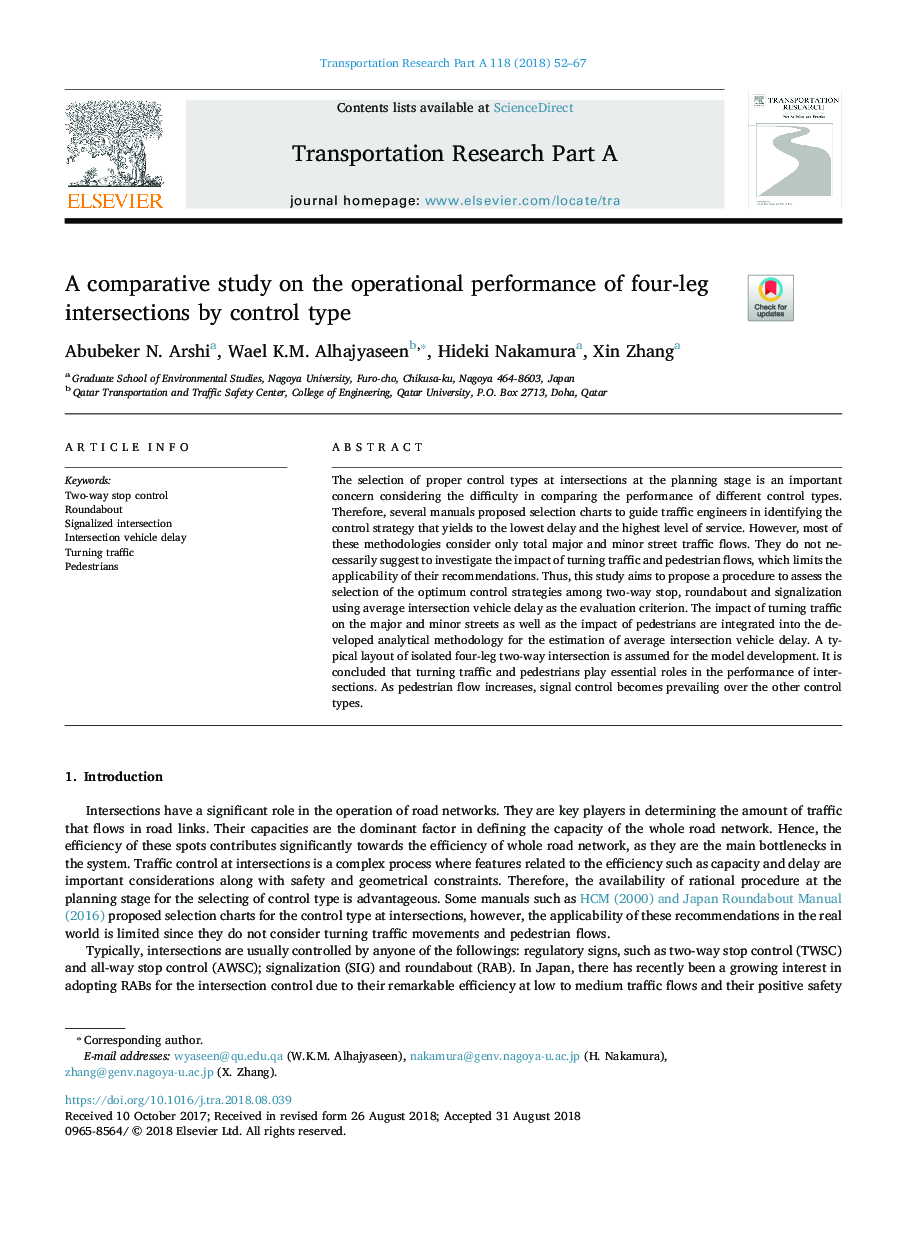| کد مقاله | کد نشریه | سال انتشار | مقاله انگلیسی | نسخه تمام متن |
|---|---|---|---|---|
| 10145871 | 1646370 | 2018 | 16 صفحه PDF | دانلود رایگان |
عنوان انگلیسی مقاله ISI
A comparative study on the operational performance of four-leg intersections by control type
ترجمه فارسی عنوان
یک مطالعه مقایسه ای در مورد عملکرد عملیات تقاطع چهار پا با نوع کنترل
دانلود مقاله + سفارش ترجمه
دانلود مقاله ISI انگلیسی
رایگان برای ایرانیان
کلمات کلیدی
کنترل توقف دو طرفه، میدان، تقاطع سیگنال داده شده، تاخیر خودرو تقاطع گردش ترافیک، پیاده روی،
ترجمه چکیده
انتخاب نوع کنترل مناسب در تقاطعات در مرحله برنامه ریزی، نگرانی مهم در نظر گرفتن مشکل در مقایسه عملکرد انواع مختلف کنترل است. بنابراین، چندین کتابچه راهنمای کاربر برای طراحی مهندسین ترافیک در شناسایی استراتژی کنترل ارائه شده برای پایین ترین تاخیر و بالاترین سطح خدمات ارائه شده است. با این حال، بسیاری از این روش ها تنها جریان کل ترافیک خیابانی عمده و کوچک را در نظر می گیرند. آنها لزوما پیشنهاد نمی کنند تا تاثیر ترافیک و جریان های عابر پیاده را بررسی کنند که کاربرد توصیه های آنها را محدود می کند. بنابراین، این مطالعه با هدف ارائه یک روش برای ارزیابی انتخاب استراتژی های کنترل بهینه در میان توقف متوقف، دور زدن و سیگنالینگ با استفاده از تاخیر وسیله نقلیه تقاطع به عنوان معیار ارزیابی می پردازد. تأثیر ترافیک چرخشی در خیابان های اصلی و جزئی و همچنین اثرات عابر پیاده ها در روش تحلیلی توسعه یافته برای برآورد میانگین تاخیر وسایل نقلیه تقاطع یکپارچه شده است. یک طرح کلی از تقاطع دو طرفه جدا شده چهار پایه برای توسعه مدل فرض شده است. نتیجه گیری می شود که چرخش ترافیک و عابر پیاده نقش اساسی در عملکرد تقاطع ها ایفا می کند. همانطور که جریان عابر پیاده افزایش می یابد، کنترل سیگنال بیش از سایر انواع کنترل می شود.
موضوعات مرتبط
مهندسی و علوم پایه
سایر رشته های مهندسی
مهندسی عمران و سازه
چکیده انگلیسی
The selection of proper control types at intersections at the planning stage is an important concern considering the difficulty in comparing the performance of different control types. Therefore, several manuals proposed selection charts to guide traffic engineers in identifying the control strategy that yields to the lowest delay and the highest level of service. However, most of these methodologies consider only total major and minor street traffic flows. They do not necessarily suggest to investigate the impact of turning traffic and pedestrian flows, which limits the applicability of their recommendations. Thus, this study aims to propose a procedure to assess the selection of the optimum control strategies among two-way stop, roundabout and signalization using average intersection vehicle delay as the evaluation criterion. The impact of turning traffic on the major and minor streets as well as the impact of pedestrians are integrated into the developed analytical methodology for the estimation of average intersection vehicle delay. A typical layout of isolated four-leg two-way intersection is assumed for the model development. It is concluded that turning traffic and pedestrians play essential roles in the performance of intersections. As pedestrian flow increases, signal control becomes prevailing over the other control types.
ناشر
Database: Elsevier - ScienceDirect (ساینس دایرکت)
Journal: Transportation Research Part A: Policy and Practice - Volume 118, December 2018, Pages 52-67
Journal: Transportation Research Part A: Policy and Practice - Volume 118, December 2018, Pages 52-67
نویسندگان
Abubeker N. Arshi, Wael K.M. Alhajyaseen, Hideki Nakamura, Xin Zhang,
